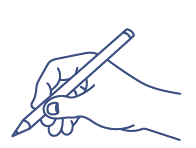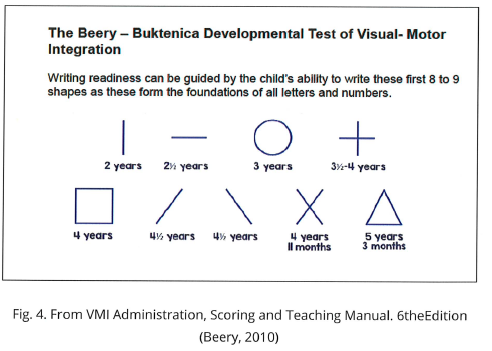Start right, write well: laying sufficient foundations for handwriting

Occupational therapist and handwriting specialist Michelle van Rooyen explains the importance of laying secure foundations for each child’s writing.
The ability and motivation to play with a ball and subsequently acquire related ball skills are almost certainly part of human nature. However, handwriting is not an innate ability but an incredibly complex process that requires the integrated engagement of numerous ‘building block’ skills, including: spoken language, gross and fine motor skills, visual motor skills (hand–eye coordination), visual perception skills, and cognitive skills (such as memory and attention). These must be sufficiently developed in order to provide children with a secure foundation for learning to write.
It is therefore vital that children are physically and cognitively prepared before they begin writing. Learning should be delivered in a child-centred, playful style, and children should progress to each new handwriting milestone (from learning print letters, to learning joins, to building fluency and speed) only when they are ready. If teaching overtakes the learner’s abilities, writing will quickly become illegible and learned mistakes will prove difficult to correct.
A personalised approach
The UK’s National Curriculum requires children to master handwriting by the time they enter Key Stage 2, which is typically when a child is seven years old. While expectations for handwriting are set out in both the Early Years Foundation Stage Framework and the National Curriculum, little guidance is given on specific teaching methods or recommended support for children who fail to meet these goals, as many do.
In this context, the expectation that children will have become proficient in this complex skill by the time they enter Key Stage 2 is ambitious. At least 10–30% of children will be unable to master handwriting by this time.1 Teaching must be flexible to suit individual needs, rather than expecting all children to have mastered handwriting by a certain age. In particular, left-handers and children with special educational needs will have different requirements, which must be taken into account.
Prerequisite skills for handwriting
Before beginning to learn to write letters, it is important that children are physically and developmentally fit to do so. Visual perception abilities, gross and fine motor skills, and general core strength are all essential prerequisites for successful handwriting. Appropriate developmental levels within these ‘building block’ skills need to be reached in order to initiate a successful handwriting journey.
The handwriting journey starts with mark-making. These are the scribbles, dots and lines that children begin to draw spontaneously during play at an early age. Alongside making these marks, children should also be able to do the following before they learn to write letters:
• Listen to and follow instructions.
• Hold a pencil efficiently.

An efficient pencil grip
• Have a preferred writing hand.
• Be able to copy the shapes below.2

The shapes above form the Beery-Buktenica Developmental Test of Visual-Motor Integration. In short, the test shows the shapes that children should be able to draw as their visual-motor skills develop between the ages of two and just over five years old.
Teach print letters first
The teaching of lowercase letters should be multi-sensory and child-centred. The National Curriculum recommends that children learn the letters in ‘letter families’ (groups of letters that are formed with similar movements). Focusing on similar movements enables the learner to build a ‘motor map’, allowing the letter shape to become embedded in the brain and muscles. This approach provides a firm basis for later handwriting progression.
Children should be fully secure in writing print letters before they are taught to join letters.3 If joining is taught before letter shapes are secure, the letter shapes can become distorted and writing will be less legible. If a child is taught to join before they are developmentally ready, this can create a legacy of handwriting problems that will be extremely challenging to resolve.
Joining letters makes use of diagonal lines. As the Berry-Buktenica diagram above demonstrates, diagonal lines are more difficult for a child to draw: the ability to form diagonal lines only emerges between the ages of four and five years old at the earliest. The use of pre-cursive letters – letters with a lead in and lead-out stroke – requires children to form diagonal lines before they are developmentally able to do so. This creates a particular problem for children with developmental delays, or ‘summer-born’ children, who are only four years old when they begin Reception. These lead-in and lead-out strokes require children to change direction more often, which adds an unnecessary level of complexity, as well as requiring more sustained pencil control. By contrast, print letters use simpler shapes with fewer directional changes.
Furthermore, there is evidence to suggest that learning print letters helps consolidate learning of letter knowledge and improves reading acquisition. The reason for this is that these letters shapes are mostly similar to those found in the printed text of reading books.
Conclusion
While many of us may take our ability to write for granted, when it comes to teaching children, we must not forget that handwriting is a highly complex skill. Schofield & Sims’ handwriting series, WriteWell, which makes use of a developmental and flexible approach, supports children throughout their handwriting journey. By beginning with teaching print letters, the series ensures that children get the fundamentals correct before moving on to the altogether more tricky business of joining letters.
The WriteWell books offer structured practice in writing each letter or join, ensuring children become familiar with each element before moving onto the next one. The progression from finger tracing to pencil tracing to writing letters independently is gradual. This approach, which keeps cognitive demand low until children become familiar with each new letter shape, enables children to feel fully secure in their ability to write every letter and join.
While each book in the series is linked to a specific year group (for example, WriteWell Books 1 to 3 are recommended for use in the Reception year), this is only a guideline, and the books are intended to be worked through at a child’s own pace.
Above all, it is essential that children are taught to write in a way that creates and builds upon secure foundations, and can be adapted to their individual needs.
To receive a free evaluation copy from the scheme, simply call 01484 607080 or email sales@schofieldandsims.co.uk.
Michelle van Rooyen is an occupational therapist with a special interest in handwriting. She has over 20 years’ experience as a practitioner and currently works as an independent therapist in homes and schools. She is an active member of the National Handwriting Association.
1How to Identify and Overcome Handwriting Difficulties by Lois Addy, p.7 (Feder & Majnemer, 2007; Rosenblum et al., 2010)
2The Beery-Buktenica Developmental Test of Visual-Motor Integration, VMI Administration, Scoring and Teaching Manual, 6th Edition (Beery, 2010)
3‘Bold Beginnings’, Ofsted, November 2017
comments powered by Disqus